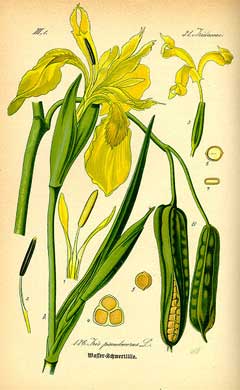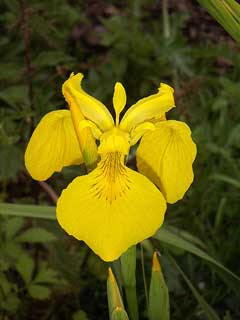 |
|
http://commons.wikimedia.org/wiki/File:Illustration_Iris_pseudacorus0.jpg |
 |
| http://commons.wikimedia.org/wiki/User:Caronna |
Translate this page:
Summary
Bloom Color: Yellow. Main Bloom Time: Late summer, Mid summer. Form: Spreading or horizontal, Upright or erect, Variable spread.
Physical Characteristics

 Iris pseudacorus is a PERENNIAL growing to 1.5 m (5ft) by 2 m (6ft) at a medium rate.
Iris pseudacorus is a PERENNIAL growing to 1.5 m (5ft) by 2 m (6ft) at a medium rate.
See above for USDA hardiness. It is hardy to UK zone 5 and is not frost tender. It is in flower from May to July. The species is hermaphrodite (has both male and female organs) and is pollinated by Bees, hoverflies. The plant is self-fertile.
Suitable for: light (sandy) and medium (loamy) soils. Suitable pH: mildly acid, neutral and basic (mildly alkaline) soils. It can grow in semi-shade (light woodland) or no shade. It prefers moist or wet soil and can grow in water. The plant can tolerates strong winds but not maritime exposure.
UK Hardiness Map
US Hardiness Map
Synonyms
Plant Habitats
Woodland Garden Sunny Edge; Dappled Shade; Meadow; Pond; Bog Garden;
Edible Uses
Edible Parts:
Edible Uses: Coffee
The seed is said to make an excellent coffee substitute as long as it is well roasted[2, 7, 61, 105, 115, 244]. Caution is advised, it might be poisonous[177].
References More on Edible Uses
Medicinal Uses
Plants For A Future can not take any responsibility for any adverse effects from the use of plants. Always seek advice from a professional before using a plant medicinally.
Astringent Cathartic Emetic Emmenagogue Odontalgic
The fresh root is astringent, cathartic, emetic, emmenagogue and odontalgic[4, 7, 61]. A slice of the root held against an aching tooth is said to bring immediate relief[244]. It was at one time widely used as a powerful cathartic but is seldom used nowadays because of its extremely acrid nature[4]. It can also cause violent vomiting and diarrhoea[244]. When dried the root loses its acridity and then only acts as an astringent[4].
References More on Medicinal Uses
The Bookshop: Edible Plant Books
Our Latest books on Perennial Plants For Food Forests and Permaculture Gardens in paperback or digital formats.

Edible Tropical Plants
Food Forest Plants for Hotter Conditions: 250+ Plants For Tropical Food Forests & Permaculture Gardens.
More

Edible Temperate Plants
Plants for Your Food Forest: 500 Plants for Temperate Food Forests & Permaculture Gardens.
More

More Books
PFAF have eight books available in paperback and digital formats. Browse the shop for more information.
Shop Now
Other Uses
Dye Essential Ink Tannin
A beautiful yellow dye is obtained from the flowers[4]. A good black dye is obtained from the root if it is mixed with iron sulphate[4, 115]. It is brown otherwise[141]. The root is a source of tannin[61] and has been used in making ink[4]. A delicately scented essential oil, obtained from the roots, has been used to adulterate the oil of Acorus calamus[245].
Special Uses
Food Forest Scented Plants
References More on Other Uses
Cultivation details
Landscape Uses:Container, Specimen. Prefers a humus rich soil[79]. Succeeds in water up to 15cm deep[24]. Requires a moist soil, especially in early summer. Prefers a position in semi-shade[188]. Plants can be grown in quite coarse grass, which can be cut annually in the autumn[233]. A delicately scented essential oil is obtained from the dried roots[245]. Members of this genus are rarely if ever troubled by browsing deer or rabbits[233]. Some named forms have been selected for their ornamental value[187]. Special Features:
Attractive foliage, Not North American native, Invasive, Naturalizing, All or parts of this plant are poisonous, Wetlands plant, Attracts butterflies, Suitable for cut flowers. In garden design, as well as the above-ground architecture of a plant, root structure considerations help in choosing plants that work together for their optimal soil requirements including nutrients and water. The root pattern is rhizomatous with underground stems sending roots and shoots along their length [2-1].
References Carbon Farming Information and Carbon Sequestration Information
Temperature Converter
Type a value in the Celsius field to convert the value to Fahrenheit:
Fahrenheit:
The PFAF Bookshop
Plants For A Future have a number of books available in paperback and digital form. Book titles include Edible Plants, Edible Perennials, Edible Trees,Edible Shrubs, Woodland Gardening, and Temperate Food Forest Plants. Our new book is Food Forest Plants For Hotter Conditions (Tropical and Sub-Tropical).
Shop Now
Plant Propagation
Seed - best sown as soon as it is ripe in a cold frame[4]. Stored seed should be sown as early in the year as possible in a cold frame. A period of cold stratification improves germination time and rates. Prick out the seedlings into individual pots when they are large enough to handle and grow them on in the greenhouse or cold frame for their first year. Plant out into their permanent positions in late spring or early summer. Division in March or October. Early autumn is best[200]. Very easy, larger clumps can be replanted direct into their permanent positions, though it is best to pot up smaller clumps and grow them on in a cold frame until they are rooting well. Plant them out in the spring.
Other Names
If available other names are mentioned here
Yellow Flag, Paleyellow iris, Iris, Yellow iris
Native Plant Search
Search over 900 plants ideal for food forests and permaculture gardens. Filter to search native plants to your area. The plants selected are the plants in our book 'Plants For Your Food Forest: 500 Plants for Temperate Food Forests and Permaculture Gardens, as well as plants chosen for our forthcoming related books for Tropical/Hot Wet Climates and Mediterranean/Hot Dry Climates. Native Plant Search
Found In
Countries where the plant has been found are listed here if the information is available
Weed Potential
Right plant wrong place. We are currently updating this section.
Please note that a plant may be invasive in one area but may not in your area so it’s worth checking.
Conservation Status
IUCN Red List of Threatened Plants Status :

| Related Plants
|
| Latin Name | Common Name | Habit | Height | Hardiness | Growth | Soil | Shade | Moisture | Edible | Medicinal | Other |
| Albizia lebbeck | Siris Tree, Woman's Tongue, East Indian Walnut | Tree | 15.0 |
10-11
| F | LMH | N | M | 1 | 2 | 4 |
| Albizia lucidior | Potka siris tree | Tree | 15.0 |
10-12
| F | LMH | SN | M | 0 | 0 | 3 |
| Albizia procera | White Siris, Tall Albizia, Forest Siris | Tree | 25.0 |
10-12
| F | LMH | N | M | 1 | 2 | 4 |
| Bobartia indica | Rush Iris | Perennial | 0.6 |
7-10
| S | L | N | DM | 0 | 0 | 1 |
| Gynandriris sisyrinchium | Spanish Nut | Perennial | 0.2 |
7-10
| | MH | SN | DM | 1 | 0 | |
| Iris cristata | Crested Iris, Dwarf crested iris | Perennial | 0.2 |
5-9
| M | LM | SN | M | 1 | 1 | |
| Iris decora | | Perennial | 0.3 |
-
| | LM | N | DM | 0 | 1 | |
| Iris douglasiana | Mountain Iris, Douglas iris | Perennial | 0.3 |
6-9
| | LM | SN | DMWe | 0 | 0 | 1 |
| Iris ensata | Japanese Water Iris | Perennial | 0.6 |
5-8
| M | LM | N | MWe | 1 | 1 | 2 |
| Iris filifolia | | Bulb | 0.5 |
-
| | LM | N | DM | 1 | 0 | |
| Iris foetidissima | Stinking Gladwin, Stinking iris, Gladwin Iris | Perennial | 1.0 |
7-10
| M | LMH | FSN | DMWe | 0 | 2 | 3 |
| Iris germanica | Purple Flag, German iris, Orris-root, Tall Bearded German Iris, Bearded Iris | Perennial | 1.0 |
4-10
| M | LM | SN | DM | 1 | 3 | 2 |
| Iris germanica florentina | Orris, Orris-root | Perennial | 0.9 |
5-10
| M | LM | SN | M | 1 | 3 | 3 |
| Iris japonica | | Perennial | 0.6 |
-
| | LM | SN | DM | 1 | 2 | 3 |
| Iris kemaonensis | | Perennial | 0.5 |
-
| | LM | SN | DM | 0 | 2 | |
| Iris macrosiphon | Bowltube Iris | Perennial | 0.2 |
-
| | LM | SN | M | 0 | 1 | 1 |
| Iris missouriensis | Rocky Mountain Iris | Perennial | 0.8 |
0-0
| | LM | SN | MWe | 1 | 2 | 1 |
| Iris pallida | Dalmation Iris, Sweet iris, Fragrant Iris, Zebra Iris | Perennial | 1.0 |
4-10
| M | LM | SN | DM | 2 | 1 | 3 |
| Iris purdyi | Purdy's Iris | Perennial | 0.4 |
-
| | LM | SN | DM | 0 | 0 | 1 |
| Iris sanguinea | Blood iris | Perennial | 0.8 |
5-9
| | LM | SN | MWe | 0 | 1 | 1 |
| Iris setosa | Beachhead Iris, Canada beachhead iris, Wild flag | Perennial | 0.6 |
4-8
| M | LM | SN | MWe | 1 | 1 | 1 |
| Iris sibirica | Siberian Iris | Perennial | 0.6 |
4-9
| F | LM | SN | MWe | 1 | 1 | 1 |
| Iris tectorum | Roof Iris, Wall iris, Japanese Roof, White Root Iris | Perennial | 0.3 |
5-9
| M | LM | SN | DM | 1 | 0 | |
| Iris tenax | Tough-Leaf Iris, Klamath iris | Perennial | 0.3 |
0-0
| | LM | SN | DM | 0 | 1 | 2 |
| Iris versicolor | Blue Flag, Harlequin blueflag | Perennial | 0.6 |
4-8
| | LM | SN | MWe | 0 | 3 | 2 |
| Solanum tuberosum | Potato, Irish potato | Perennial | 1.0 |
7-10
| | LMH | N | M | 5 | 2 | 3 |
| Tagetes filifolia | Irish Lace | Annual | 0.4 |
8-11
| | LMH | N | DM | 1 | 0 | 2 |
|
Growth: S = slow M = medium F = fast. Soil: L = light (sandy) M = medium H = heavy (clay). pH: A = acid N = neutral B = basic (alkaline). Shade: F = full shade S = semi-shade N = no shade. Moisture: D = dry M = Moist We = wet Wa = water.

Expert comment
Author
L.
Botanical References
17200
Links / References
For a list of references used on this page please go here
Readers comment